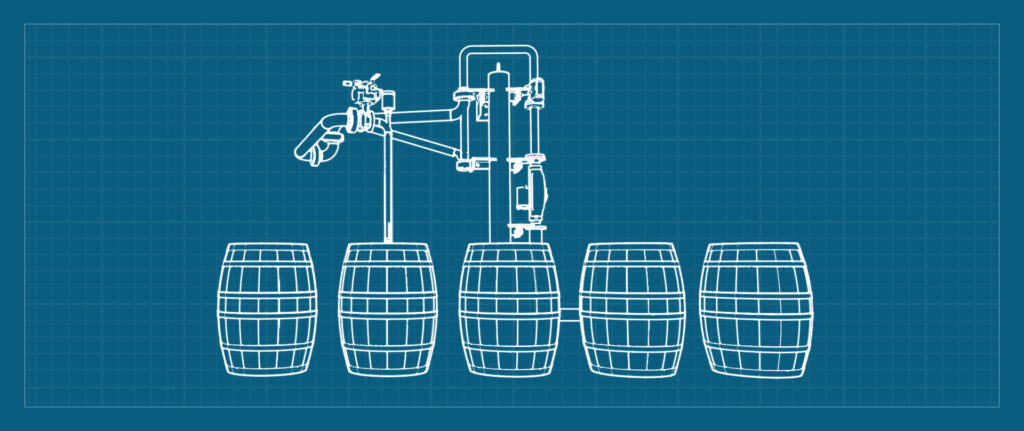Scotland’s food and drink sector is central to the country’s economy. Bringing in around £14 billion every year, it employs more than 115,000 people and accounts for one in five manufacturing jobs. Scotland has almost 19,000 food and drink businesses and, perhaps unsurprisingly, more than a third of Scotland’s total food and drink output is made up by Scotch whisky exports alone.
As is the case within pretty much every sector, food and drink companies globally find themselves under pressure to adopt industry 4.0 technologies and enable smart data that can propel them into the 21st century. Those within the supply chain that have managed to do so are already reaping the benefits of reduced costs, time and energy, with increased control over manufacturing methods through a more precise understanding of their process.
A taste of innovation
At the National Manufacturing Institute Scotland (NMIS), we have been working within a consortium of companies to create a digital whisky cask filling process that we estimate could save the whisky industry millions of pounds each year in inventory costs.
The aim was to help Diageo find a solution for the age-old issue of over and underfilling casks. When a cask is underfilled, it wastes precious storage space – a significant problem when casks are stored for years at a time. Conversely, overfilling creates spillage leading to valuable product loss. An American “standard” barrel, for instance, should hold 200 litres of whisky; however, despite the name, there is nothing standard about it. They can vary significantly in size, sometimes by +/- 20%. This means that, historically, there was no way to know precisely how much whisky to fill a cask with.
In an attempt to solve this problem once and for all, we have been working with our partners to create an industry demonstrator, complete with an innovative whisky cask-filling test rig and cyber-physical system. The system incorporates a digital twin that replicates the physical process of filling a cask in a virtual environment to avoid unnecessary over or underfilling. It also allows us to accurately map and track the cask itself and the entire filling process. By providing real-time data on fill volume, operators can now account for every drop into each cask.
In testing, we have consistently created a 99% fill on a 200-litre cask in under one minute. That is a 33% reduction on average filling times. Commercially, this has the added benefit of allowing distillers to evaluate the quantity of barrels and inventory warehouses required due to the increase in volume in each cask. This reduction in storage requirements not only supports businesses with capital investment savings in infrastructure and logistics, but also has an impact on carbon footprint due to the reduction in cask management.
The collaborative nature of the project joined NMIS design and digital manufacturing expertise with Siemens’ instrumentation know-how and Kigtek’s process and control understanding. This combination of knowledge allowed us to devise a revolutionary system with immense benefits for a multi-billion-pound industry crucial to Scotland’s economy.
The ingredients for automation


At NMIS, we have been working on a phased digital twin approach where there is a prescriptive element, a strategy that has been achieved within our work on the digital cask filling process before we can begin the predictive element.
That prescriptive approach is founded on current technologies and engineering toolsets such as modelling and design. We provide additional context to these toolsets using virtual reality (VR) and augmented reality (AR) devices supplemented by data sets from the physical system. This allows us to contextualise and visualise a digital representation of a physical manufacturing environment – just as we can now access a digital twin that replicates the physical process of filling a cask precisely.
The predictive element will take us that step further, allowing manufacturers to analyse data sets in real-time and automate control and prediction methods to keep systems running at optimum conditions. Manufacturers would react rapidly to any situation by sending information back to the machine in a remote location. Eventually, the goal is for this to be automated with very minimal human intervention.
What is clear, both through prescriptive and predictive digital twinning, is that we will be able to work smarter and be more agile in our approach, allowing manufacturers to be more competitive on a global scale. A digital twin will allow for better planning with an element of de-risking from virtually modelling the results, which are likely to be achieved through simulation in an AR or VR environment. Manufacturers will have a more comprehensive overview of what is going on within the process. They will be able to respond to situations faster to prevent issues that are likely to generate loss of time, product and energy, and increase the cost of manufacture.
A glass half full approach
There is immense potential for this kind of technology within the food and drinks industry as businesses adopt digital processes to inform and improve their manufacturing output. There will, of course, be concerns from such a traditional industry that introducing technology will impact the standard of products much-loved by consumers – in many cases for centuries.
The food and drinks sector is yet to embrace the benefits of a fully data-led approach to manufacturing. However, innovation is nothing new for this sector. As manufacturers embrace industry 4.0, they will begin to realise the benefits of consistent production where spillages, spoiled batches, and incorrect production levels are significantly reduced. To start that digital transformation, manufacturers must begin to look at data acquisition from their processes.
We see real and tangible opportunities for the industry. At NMIS, we look forward to working with food and drink manufacturers to help overcome some of the obstacles to adopting industry 4.0. Gaining insight from the production line will only improve the manufacture and allow space for growth.
The whisky industry remains one of Scotland’s greatest exports and, while its tradition plays a role in developing its character, we believe that there is room left in the glass for data led innovation – we’ll toast to that.




